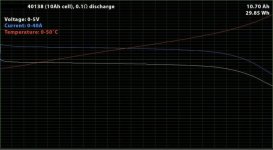oatnet
1 MW
I bought 16 of these cells from Chad (c-hessman) locally, he is now selling them here: http://endless-sphere.com/forums/viewtopic.php?f=9&t=7533
I was told that they are the new headway cylindrical cells, 5c continous, 10c burst. Packaging is blue transparent plastic/vinyl? over metal tube and serial number. I was skeptical of the screw-type ends before I bought, but now I really like them and prefer them over older bolts, should make cell-replacement a snap.
I discharged a cell on my CBA-II, and got this curve hot from a voltfreaks single-cell (3.73v) charger. I'll graph more discharges at 2c and 3c then layer them over this curve, but a full 5c test will exceed the wattage the CBA-II handles. Someone reported they sent a few cells to Doc, whose sophisticated setup will give much more robust data and better detail.
Start temp was @26c (if I remember correctly), end temp 31.1c. I got 9.2ah because I stopped the discharge early at 2.6v to protect the cell, I am sure I would have gotten the full 10ah if I took it all the way down to 2.0v. I'll feel like pulling 8ah duty cycles will represent an 80% DOD that will preserve the cells, plus they will probably get a little stronger as a few dozen cycles wakes up the chemistry.
-JD
View attachment 38120 hh23 12334.JPG
PS: Not sure why this attachment isn't showing up as a picture!
I was told that they are the new headway cylindrical cells, 5c continous, 10c burst. Packaging is blue transparent plastic/vinyl? over metal tube and serial number. I was skeptical of the screw-type ends before I bought, but now I really like them and prefer them over older bolts, should make cell-replacement a snap.
I discharged a cell on my CBA-II, and got this curve hot from a voltfreaks single-cell (3.73v) charger. I'll graph more discharges at 2c and 3c then layer them over this curve, but a full 5c test will exceed the wattage the CBA-II handles. Someone reported they sent a few cells to Doc, whose sophisticated setup will give much more robust data and better detail.
Start temp was @26c (if I remember correctly), end temp 31.1c. I got 9.2ah because I stopped the discharge early at 2.6v to protect the cell, I am sure I would have gotten the full 10ah if I took it all the way down to 2.0v. I'll feel like pulling 8ah duty cycles will represent an 80% DOD that will preserve the cells, plus they will probably get a little stronger as a few dozen cycles wakes up the chemistry.
-JD
View attachment 38120 hh23 12334.JPG
PS: Not sure why this attachment isn't showing up as a picture!




